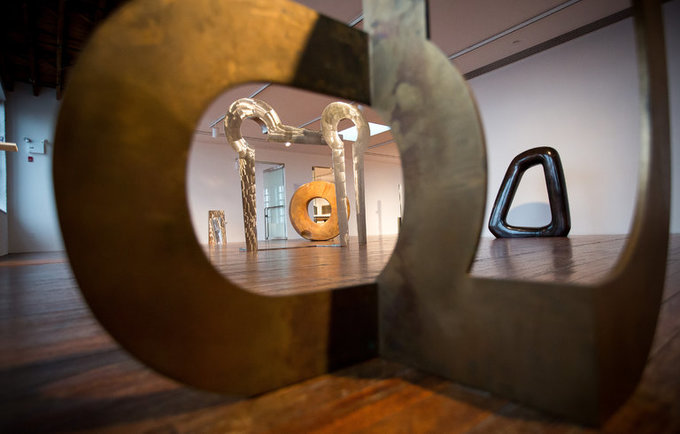“For one with a background like myself, the question of identity is very uncertain. And I think it’s only in art that it was ever possible for me to find any identity at all.” – Isamu Noguchi
It’s been 75 years since President Franklin D. Roosevelt would sign Executive Order 9066 which relocated and incarcerated between 110,000 and 120,000 Japanese Americans. The Noguchi Museum, located in Long Island City, New York, is marking the anniversary this year with two dozen sculptures and objects that Noguchi made before, during, and after his time spent voluntarily interned at the Poston War Relocation Center with the exhibit, “Self-Interned, 1942: Noguchi in Poston War Relocation Center.”
Poetry of Tortured Earth
The works include the sculpture, Double Red Mountain (1969), a piece he made 25 years after he was released from the camp that represented the vast Arizona desert where Poston was located. Included in the collection are two wall sculptures, This Tortured Earth (1942-43) and Yellow Landscape (1943) which is said to depict the racist slur directed at Asian people during the height of World War II. Another piece of Noguchi artwork is a piece of driftwood the size of a palm that he carved into the shape of a teardrop while he was in the internment camp.

Geometric and Organic: Noguchi’s Artistic Dichotomy
Isamu Noguchi was a Japanese-American artist whose career spanned an impressive six decades. His art has been greatly inspired by both traditional Japanese art form, as well as inevitable influences from the New York Abstract Expressionist and American contemporaries of his time. Noguchi was essentially a sculptor, using largely organic materials such as stone and wood in biomorphic style. But he has also worked on design objects and furniture (the famous Noguchi table still in production today), as a critical figure in postwar art, design and architecture scene. Noguchi’s artistic career would begin in the early 1920s when he apprenticed for Gutzon Borglum, best known as the creator of the Mount Rushmore National Memorial. However, discouraged by that experience (he was told “talentless”), Noguchi would enroll as a premed student at Columbia University in 1922. However, while in school, Noguchi would be re-acquainted with the art world by influential friends and in 1924, he took night classes at the Leonardo da Vinci Art School.
Within three months, Noguchi would hold his first exhibit and soon dropped out of Columbia University to pursue sculpting full-time. Guggenheim Fellowship award in 1927 and travel to Paris to work as an assistant to Constantin Brancusi for the following 2 years, was single most important turning point to his artistic career. By 1940, his nine-ton stainless steel sculpture entitled News was unveiled at the Rockefeller Center and was met with much praise.

Interning Political Expression
But on December 7th, 1941, the Japanese bombed Pearl Harbor in a surprise attack. And on February 19, just two months after the strike, President Franklin D. Roosevelt would sign Executive Order 9066.
Noguchi was the son of a Japanese father and a Caucasian mother born in America and was a New York resident. And while the order did not include him because he lived outside the affected zone, he would enter the Poston internment camp voluntarily.
While interned, Noguchi would write, “When people ask me why I, a Eurasian sculptor from New York, have come so far into the Arizona desert to be locked up with the evacuated Japanese from the West coast, I sometimes wonder myself.”
“I reply that because of my peculiar background I felt this war very keenly and wished to serve the cause of democracy in the best way that seemed open to me.”

He’d hoped that his status as a well-known artist would make him an unofficial spokesperson in Poston for the Japanese Americans. Thinking he could make the camp more humane, Noguchi would first work in a carpentry shop to design parks and recreational areas such as baseball fields and swimming pools. But after two months interned, he accepted that the War Relocation Authority would never allow him to implement any of his designs.
He was not trusted, and many thought he was a spy with nothing in common with the internees. The Japanese Americans perceived him as a “famous artist from Manhattan” who during his time there was able to purchase art supplies, work on commissions, and even finish a bust of Ginger Rogers made of pink Georgia marble.

It Is Weight That Gives Meaning To Weightlessness-Isamu Noguchi
It would take Noguchi four months to be granted a leave from which he never returned. For three years, the FBI accused him of espionage and would track his activities.
Following the Second World War, Noguchi went to Japan and spent years of exploring the social issues he upheld as a political activist and continued to search for an artistic redemption. Noguchi’s deep depression would finally be lifted. “I was finally free of all causes . . . I resolved henceforth to be an artist only.”
Walking through the exhibition and sculptures “This Tortured Earth” (1942-43) and “Yellow Landscape” (1943) that Noguchi has created during the time, the physical blueprint of political struggles and artistic journeys between the East and West feels all so abstract and blurred beauty to us. Quietly protesting in aging steels and stones after all.



![[Left] Kusama with her piece Dots Obsession, 2012, via AWARE, [Right] Yayoi Kusama (Courtesy Whitney Museum of American Art) | Source: thecollector.com](https://www.artdex.com/wp-content/uploads/2024/04/Left-Kusama-with-her-piece-Dots-Obsession-2012-via-AWARE-Right-Yayoi-Kusama-Courtesy-Whitney-Museum-of-American-Art-Source-thecollector.com--300x172.png)



